Digital Marketing Strategies for the Hospitality Industry Analysis
VerifiedAdded on 2023/01/13
|12
|3151
|62
Report
AI Summary
This report provides a comprehensive overview of digital marketing within the hospitality industry, using Hilton as a case study. It begins by outlining the digital marketing landscape, contrasting online and offline marketing concepts, and examining consumer trends fueling its growth. The report then assesses various digital tools adopted by hospitality organizations, including the 7Ps of marketing, and evaluates the development of e-commerce and digital marketing channels in comparison to traditional physical channels. The analysis covers key aspects such as branding, customer engagement, and the impact of digital strategies on sales and revenue, ultimately highlighting the importance of adapting to evolving consumer behaviors and leveraging digital platforms for effective marketing and business expansion in the competitive global market.
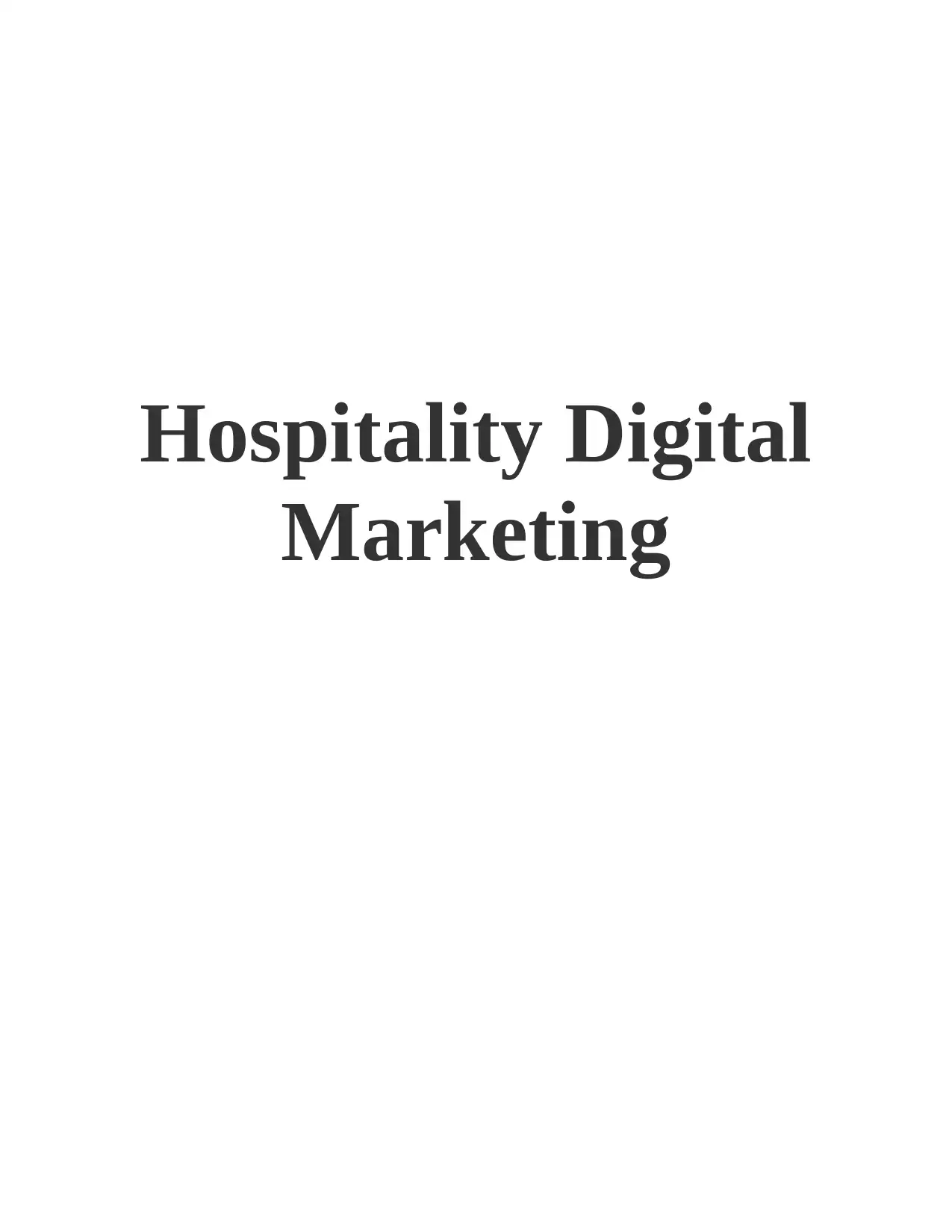
Hospitality Digital
Marketing
Marketing
Paraphrase This Document
Need a fresh take? Get an instant paraphrase of this document with our AI Paraphraser
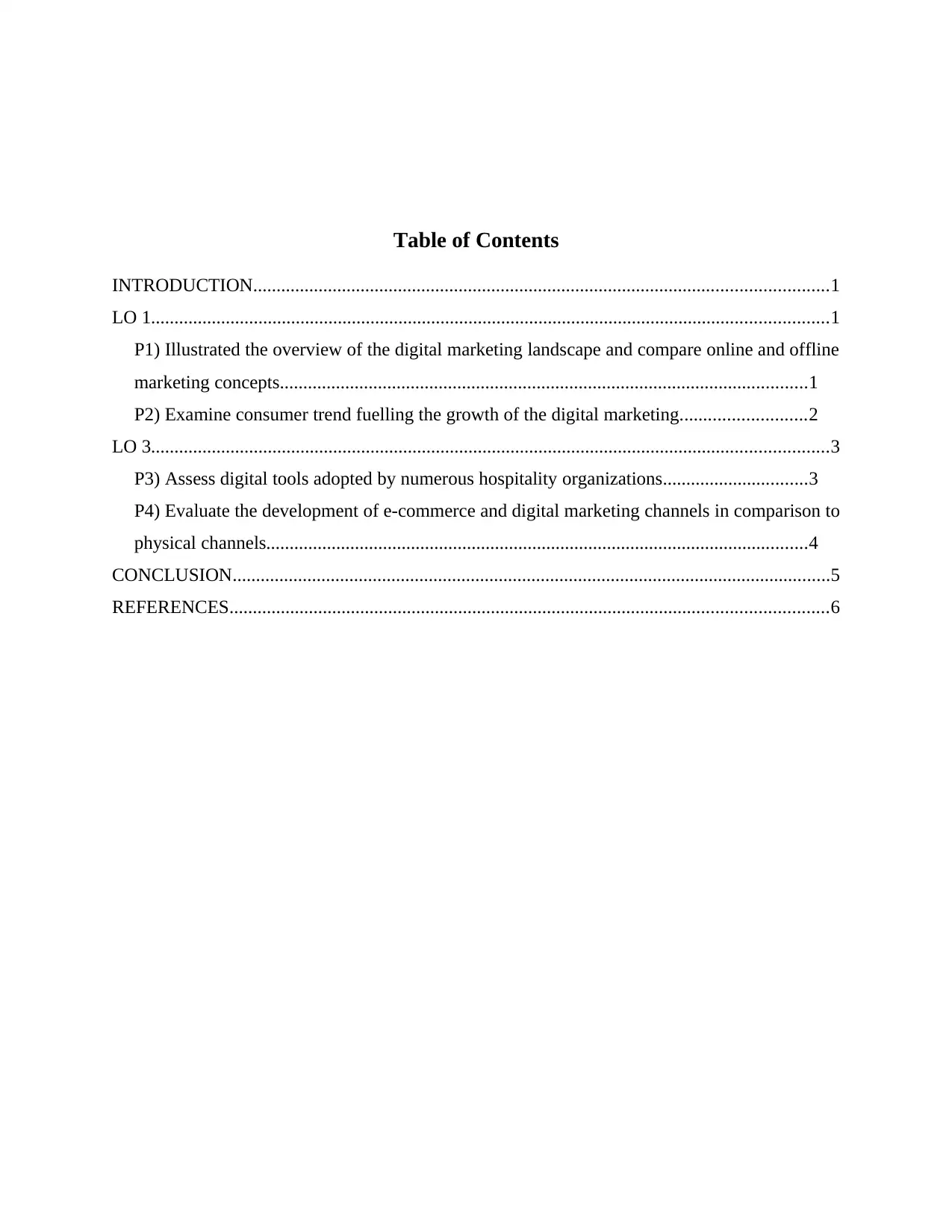
Table of Contents
INTRODUCTION...........................................................................................................................1
LO 1.................................................................................................................................................1
P1) Illustrated the overview of the digital marketing landscape and compare online and offline
marketing concepts.................................................................................................................1
P2) Examine consumer trend fuelling the growth of the digital marketing...........................2
LO 3.................................................................................................................................................3
P3) Assess digital tools adopted by numerous hospitality organizations...............................3
P4) Evaluate the development of e-commerce and digital marketing channels in comparison to
physical channels....................................................................................................................4
CONCLUSION................................................................................................................................5
REFERENCES................................................................................................................................6
INTRODUCTION...........................................................................................................................1
LO 1.................................................................................................................................................1
P1) Illustrated the overview of the digital marketing landscape and compare online and offline
marketing concepts.................................................................................................................1
P2) Examine consumer trend fuelling the growth of the digital marketing...........................2
LO 3.................................................................................................................................................3
P3) Assess digital tools adopted by numerous hospitality organizations...............................3
P4) Evaluate the development of e-commerce and digital marketing channels in comparison to
physical channels....................................................................................................................4
CONCLUSION................................................................................................................................5
REFERENCES................................................................................................................................6
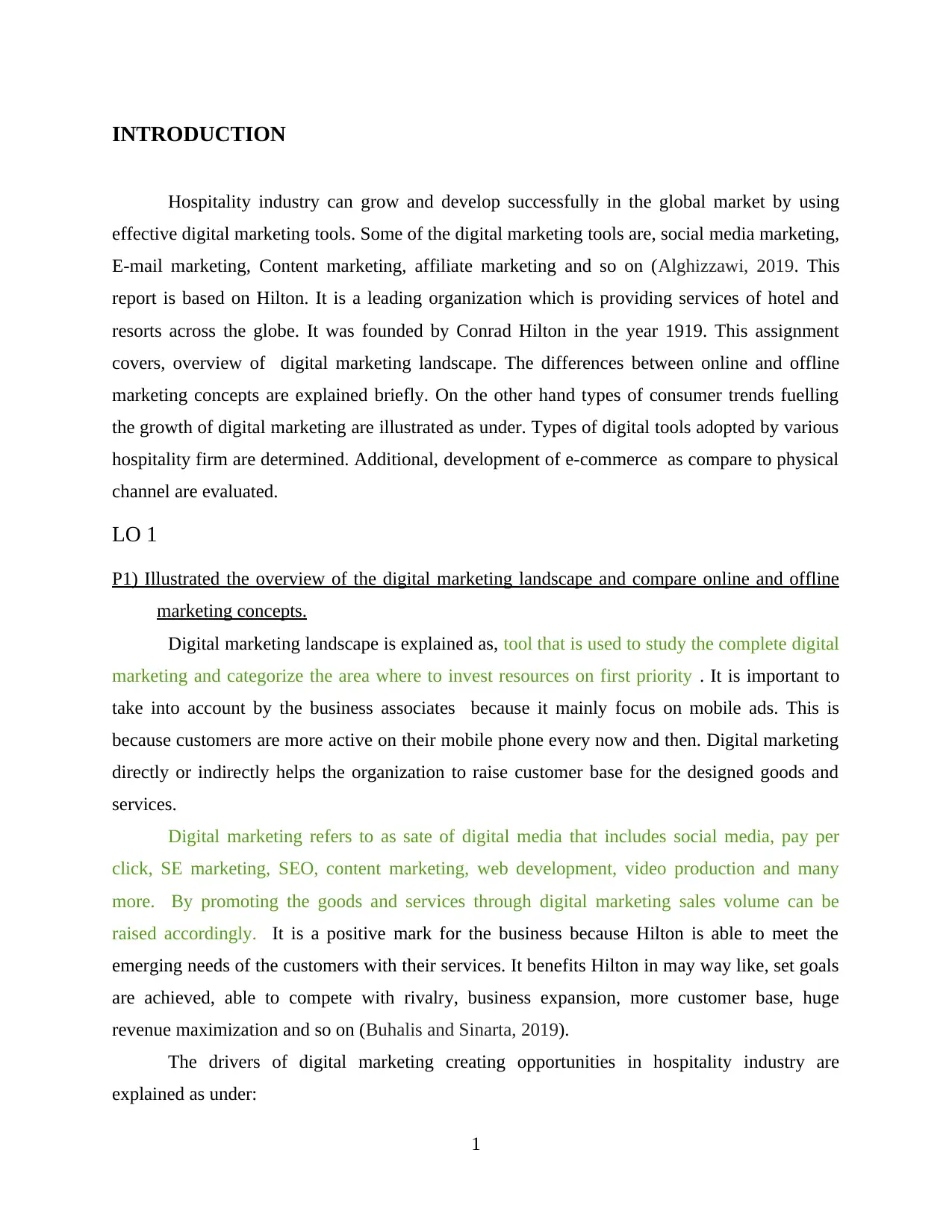
INTRODUCTION
Hospitality industry can grow and develop successfully in the global market by using
effective digital marketing tools. Some of the digital marketing tools are, social media marketing,
E-mail marketing, Content marketing, affiliate marketing and so on (Alghizzawi, 2019. This
report is based on Hilton. It is a leading organization which is providing services of hotel and
resorts across the globe. It was founded by Conrad Hilton in the year 1919. This assignment
covers, overview of digital marketing landscape. The differences between online and offline
marketing concepts are explained briefly. On the other hand types of consumer trends fuelling
the growth of digital marketing are illustrated as under. Types of digital tools adopted by various
hospitality firm are determined. Additional, development of e-commerce as compare to physical
channel are evaluated.
LO 1
P1) Illustrated the overview of the digital marketing landscape and compare online and offline
marketing concepts.
Digital marketing landscape is explained as, tool that is used to study the complete digital
marketing and categorize the area where to invest resources on first priority . It is important to
take into account by the business associates because it mainly focus on mobile ads. This is
because customers are more active on their mobile phone every now and then. Digital marketing
directly or indirectly helps the organization to raise customer base for the designed goods and
services.
Digital marketing refers to as sate of digital media that includes social media, pay per
click, SE marketing, SEO, content marketing, web development, video production and many
more. By promoting the goods and services through digital marketing sales volume can be
raised accordingly. It is a positive mark for the business because Hilton is able to meet the
emerging needs of the customers with their services. It benefits Hilton in may way like, set goals
are achieved, able to compete with rivalry, business expansion, more customer base, huge
revenue maximization and so on (Buhalis and Sinarta, 2019).
The drivers of digital marketing creating opportunities in hospitality industry are
explained as under:
1
Hospitality industry can grow and develop successfully in the global market by using
effective digital marketing tools. Some of the digital marketing tools are, social media marketing,
E-mail marketing, Content marketing, affiliate marketing and so on (Alghizzawi, 2019. This
report is based on Hilton. It is a leading organization which is providing services of hotel and
resorts across the globe. It was founded by Conrad Hilton in the year 1919. This assignment
covers, overview of digital marketing landscape. The differences between online and offline
marketing concepts are explained briefly. On the other hand types of consumer trends fuelling
the growth of digital marketing are illustrated as under. Types of digital tools adopted by various
hospitality firm are determined. Additional, development of e-commerce as compare to physical
channel are evaluated.
LO 1
P1) Illustrated the overview of the digital marketing landscape and compare online and offline
marketing concepts.
Digital marketing landscape is explained as, tool that is used to study the complete digital
marketing and categorize the area where to invest resources on first priority . It is important to
take into account by the business associates because it mainly focus on mobile ads. This is
because customers are more active on their mobile phone every now and then. Digital marketing
directly or indirectly helps the organization to raise customer base for the designed goods and
services.
Digital marketing refers to as sate of digital media that includes social media, pay per
click, SE marketing, SEO, content marketing, web development, video production and many
more. By promoting the goods and services through digital marketing sales volume can be
raised accordingly. It is a positive mark for the business because Hilton is able to meet the
emerging needs of the customers with their services. It benefits Hilton in may way like, set goals
are achieved, able to compete with rivalry, business expansion, more customer base, huge
revenue maximization and so on (Buhalis and Sinarta, 2019).
The drivers of digital marketing creating opportunities in hospitality industry are
explained as under:
1
⊘ This is a preview!⊘
Do you want full access?
Subscribe today to unlock all pages.

Trusted by 1+ million students worldwide
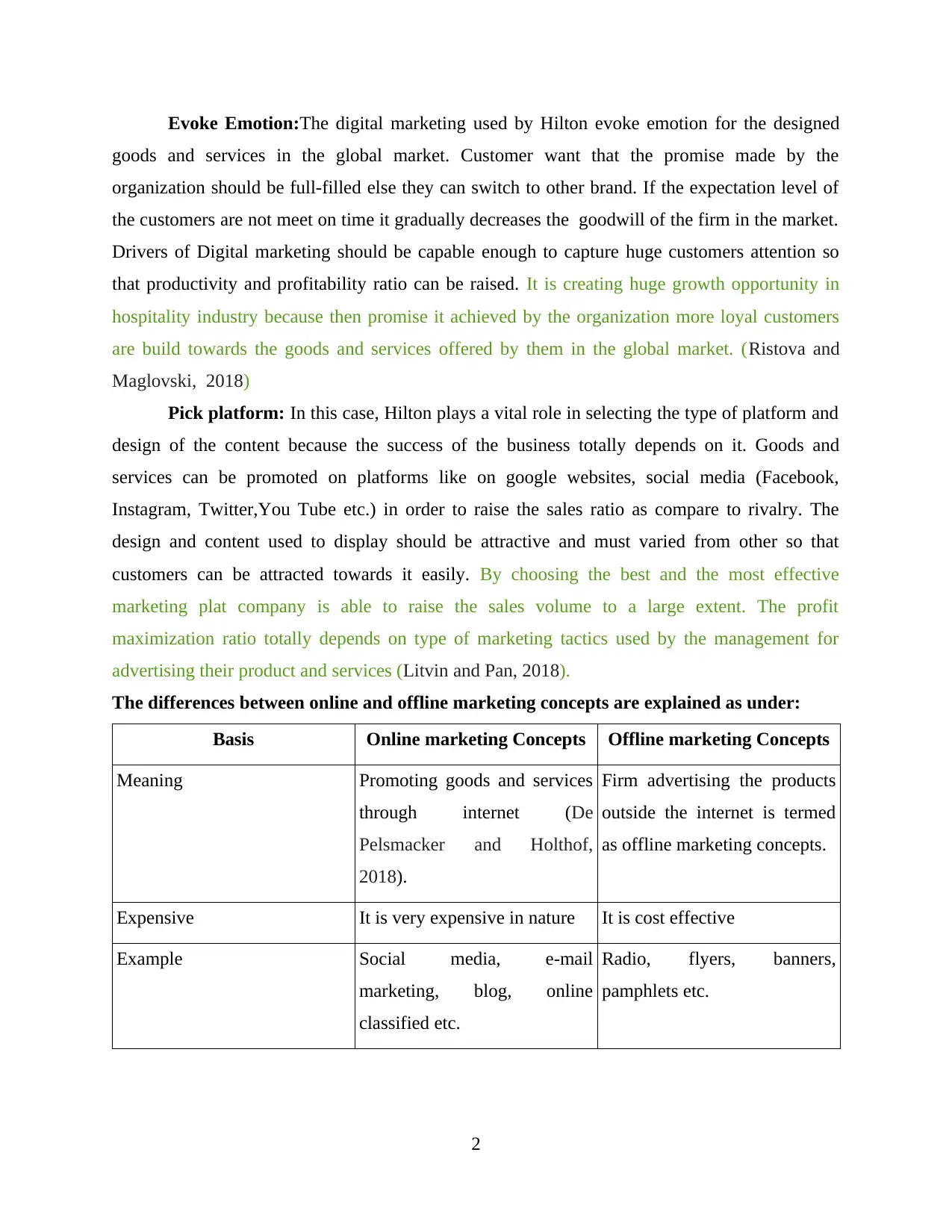
Evoke Emotion:The digital marketing used by Hilton evoke emotion for the designed
goods and services in the global market. Customer want that the promise made by the
organization should be full-filled else they can switch to other brand. If the expectation level of
the customers are not meet on time it gradually decreases the goodwill of the firm in the market.
Drivers of Digital marketing should be capable enough to capture huge customers attention so
that productivity and profitability ratio can be raised. It is creating huge growth opportunity in
hospitality industry because then promise it achieved by the organization more loyal customers
are build towards the goods and services offered by them in the global market. (Ristova and
Maglovski, 2018)
Pick platform: In this case, Hilton plays a vital role in selecting the type of platform and
design of the content because the success of the business totally depends on it. Goods and
services can be promoted on platforms like on google websites, social media (Facebook,
Instagram, Twitter,You Tube etc.) in order to raise the sales ratio as compare to rivalry. The
design and content used to display should be attractive and must varied from other so that
customers can be attracted towards it easily. By choosing the best and the most effective
marketing plat company is able to raise the sales volume to a large extent. The profit
maximization ratio totally depends on type of marketing tactics used by the management for
advertising their product and services (Litvin and Pan, 2018).
The differences between online and offline marketing concepts are explained as under:
Basis Online marketing Concepts Offline marketing Concepts
Meaning Promoting goods and services
through internet (De
Pelsmacker and Holthof,
2018).
Firm advertising the products
outside the internet is termed
as offline marketing concepts.
Expensive It is very expensive in nature It is cost effective
Example Social media, e-mail
marketing, blog, online
classified etc.
Radio, flyers, banners,
pamphlets etc.
2
goods and services in the global market. Customer want that the promise made by the
organization should be full-filled else they can switch to other brand. If the expectation level of
the customers are not meet on time it gradually decreases the goodwill of the firm in the market.
Drivers of Digital marketing should be capable enough to capture huge customers attention so
that productivity and profitability ratio can be raised. It is creating huge growth opportunity in
hospitality industry because then promise it achieved by the organization more loyal customers
are build towards the goods and services offered by them in the global market. (Ristova and
Maglovski, 2018)
Pick platform: In this case, Hilton plays a vital role in selecting the type of platform and
design of the content because the success of the business totally depends on it. Goods and
services can be promoted on platforms like on google websites, social media (Facebook,
Instagram, Twitter,You Tube etc.) in order to raise the sales ratio as compare to rivalry. The
design and content used to display should be attractive and must varied from other so that
customers can be attracted towards it easily. By choosing the best and the most effective
marketing plat company is able to raise the sales volume to a large extent. The profit
maximization ratio totally depends on type of marketing tactics used by the management for
advertising their product and services (Litvin and Pan, 2018).
The differences between online and offline marketing concepts are explained as under:
Basis Online marketing Concepts Offline marketing Concepts
Meaning Promoting goods and services
through internet (De
Pelsmacker and Holthof,
2018).
Firm advertising the products
outside the internet is termed
as offline marketing concepts.
Expensive It is very expensive in nature It is cost effective
Example Social media, e-mail
marketing, blog, online
classified etc.
Radio, flyers, banners,
pamphlets etc.
2
Paraphrase This Document
Need a fresh take? Get an instant paraphrase of this document with our AI Paraphraser
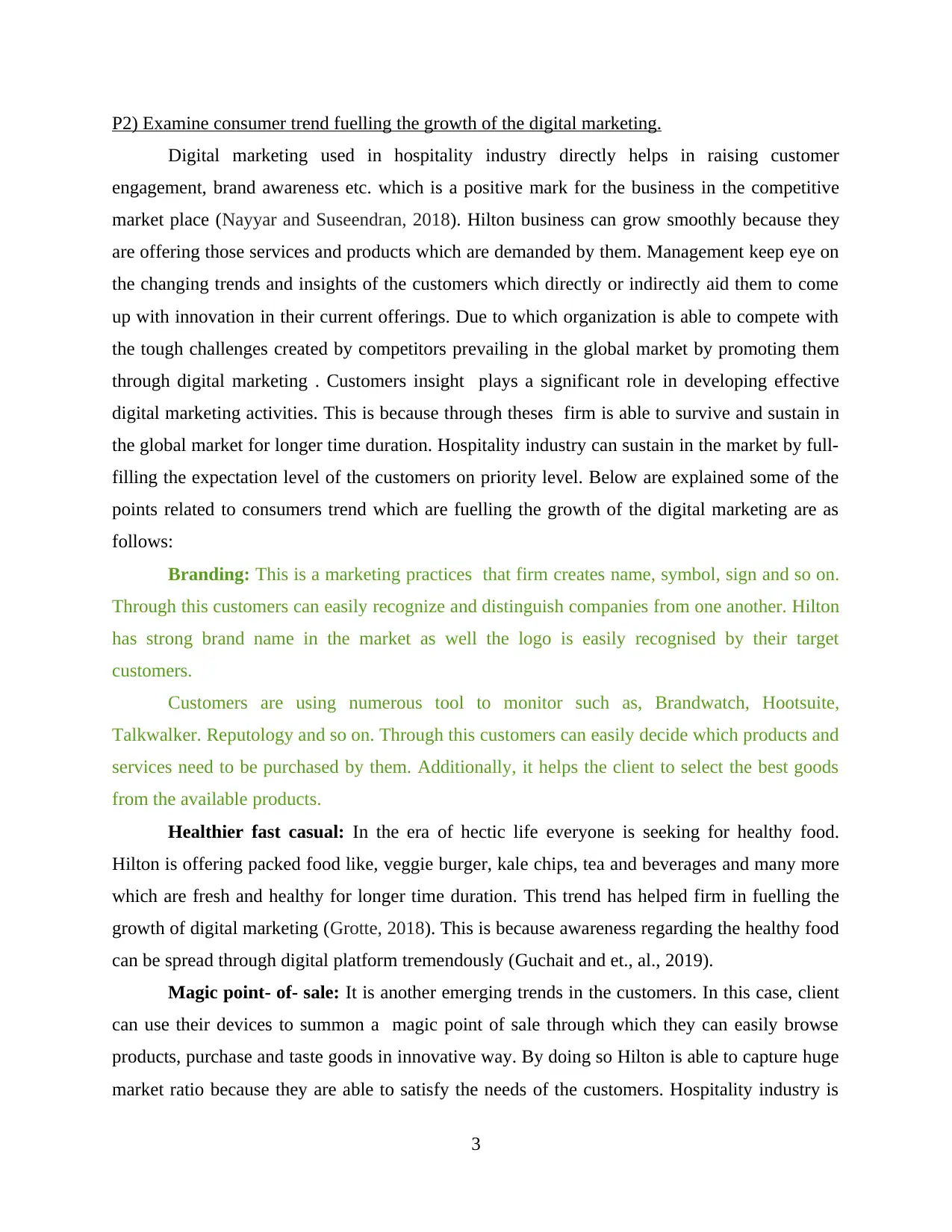
P2) Examine consumer trend fuelling the growth of the digital marketing.
Digital marketing used in hospitality industry directly helps in raising customer
engagement, brand awareness etc. which is a positive mark for the business in the competitive
market place (Nayyar and Suseendran, 2018). Hilton business can grow smoothly because they
are offering those services and products which are demanded by them. Management keep eye on
the changing trends and insights of the customers which directly or indirectly aid them to come
up with innovation in their current offerings. Due to which organization is able to compete with
the tough challenges created by competitors prevailing in the global market by promoting them
through digital marketing . Customers insight plays a significant role in developing effective
digital marketing activities. This is because through theses firm is able to survive and sustain in
the global market for longer time duration. Hospitality industry can sustain in the market by full-
filling the expectation level of the customers on priority level. Below are explained some of the
points related to consumers trend which are fuelling the growth of the digital marketing are as
follows:
Branding: This is a marketing practices that firm creates name, symbol, sign and so on.
Through this customers can easily recognize and distinguish companies from one another. Hilton
has strong brand name in the market as well the logo is easily recognised by their target
customers.
Customers are using numerous tool to monitor such as, Brandwatch, Hootsuite,
Talkwalker. Reputology and so on. Through this customers can easily decide which products and
services need to be purchased by them. Additionally, it helps the client to select the best goods
from the available products.
Healthier fast casual: In the era of hectic life everyone is seeking for healthy food.
Hilton is offering packed food like, veggie burger, kale chips, tea and beverages and many more
which are fresh and healthy for longer time duration. This trend has helped firm in fuelling the
growth of digital marketing (Grotte, 2018). This is because awareness regarding the healthy food
can be spread through digital platform tremendously (Guchait and et., al., 2019).
Magic point- of- sale: It is another emerging trends in the customers. In this case, client
can use their devices to summon a magic point of sale through which they can easily browse
products, purchase and taste goods in innovative way. By doing so Hilton is able to capture huge
market ratio because they are able to satisfy the needs of the customers. Hospitality industry is
3
Digital marketing used in hospitality industry directly helps in raising customer
engagement, brand awareness etc. which is a positive mark for the business in the competitive
market place (Nayyar and Suseendran, 2018). Hilton business can grow smoothly because they
are offering those services and products which are demanded by them. Management keep eye on
the changing trends and insights of the customers which directly or indirectly aid them to come
up with innovation in their current offerings. Due to which organization is able to compete with
the tough challenges created by competitors prevailing in the global market by promoting them
through digital marketing . Customers insight plays a significant role in developing effective
digital marketing activities. This is because through theses firm is able to survive and sustain in
the global market for longer time duration. Hospitality industry can sustain in the market by full-
filling the expectation level of the customers on priority level. Below are explained some of the
points related to consumers trend which are fuelling the growth of the digital marketing are as
follows:
Branding: This is a marketing practices that firm creates name, symbol, sign and so on.
Through this customers can easily recognize and distinguish companies from one another. Hilton
has strong brand name in the market as well the logo is easily recognised by their target
customers.
Customers are using numerous tool to monitor such as, Brandwatch, Hootsuite,
Talkwalker. Reputology and so on. Through this customers can easily decide which products and
services need to be purchased by them. Additionally, it helps the client to select the best goods
from the available products.
Healthier fast casual: In the era of hectic life everyone is seeking for healthy food.
Hilton is offering packed food like, veggie burger, kale chips, tea and beverages and many more
which are fresh and healthy for longer time duration. This trend has helped firm in fuelling the
growth of digital marketing (Grotte, 2018). This is because awareness regarding the healthy food
can be spread through digital platform tremendously (Guchait and et., al., 2019).
Magic point- of- sale: It is another emerging trends in the customers. In this case, client
can use their devices to summon a magic point of sale through which they can easily browse
products, purchase and taste goods in innovative way. By doing so Hilton is able to capture huge
market ratio because they are able to satisfy the needs of the customers. Hospitality industry is
3
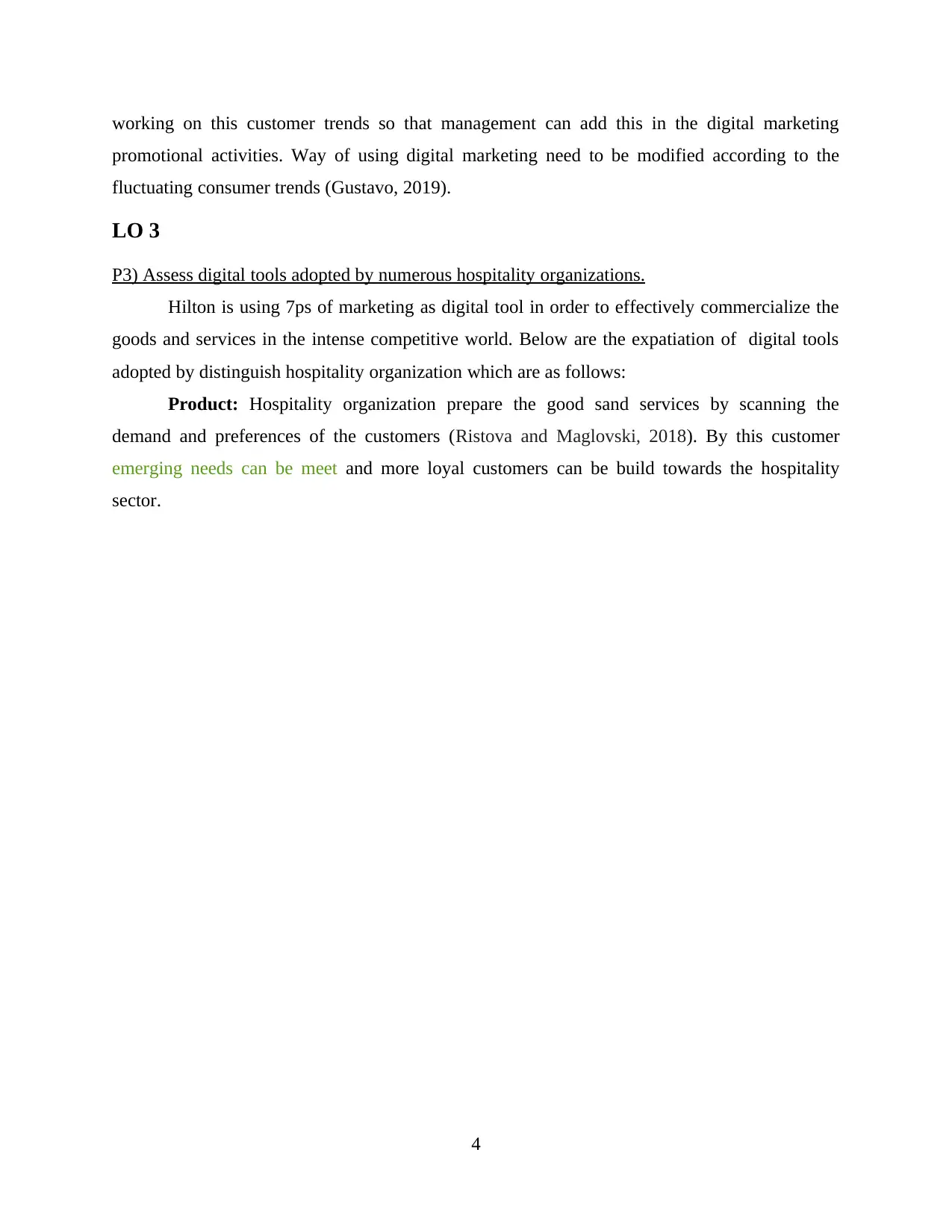
working on this customer trends so that management can add this in the digital marketing
promotional activities. Way of using digital marketing need to be modified according to the
fluctuating consumer trends (Gustavo, 2019).
LO 3
P3) Assess digital tools adopted by numerous hospitality organizations.
Hilton is using 7ps of marketing as digital tool in order to effectively commercialize the
goods and services in the intense competitive world. Below are the expatiation of digital tools
adopted by distinguish hospitality organization which are as follows:
Product: Hospitality organization prepare the good sand services by scanning the
demand and preferences of the customers (Ristova and Maglovski, 2018). By this customer
emerging needs can be meet and more loyal customers can be build towards the hospitality
sector.
4
promotional activities. Way of using digital marketing need to be modified according to the
fluctuating consumer trends (Gustavo, 2019).
LO 3
P3) Assess digital tools adopted by numerous hospitality organizations.
Hilton is using 7ps of marketing as digital tool in order to effectively commercialize the
goods and services in the intense competitive world. Below are the expatiation of digital tools
adopted by distinguish hospitality organization which are as follows:
Product: Hospitality organization prepare the good sand services by scanning the
demand and preferences of the customers (Ristova and Maglovski, 2018). By this customer
emerging needs can be meet and more loyal customers can be build towards the hospitality
sector.
4
⊘ This is a preview!⊘
Do you want full access?
Subscribe today to unlock all pages.

Trusted by 1+ million students worldwide
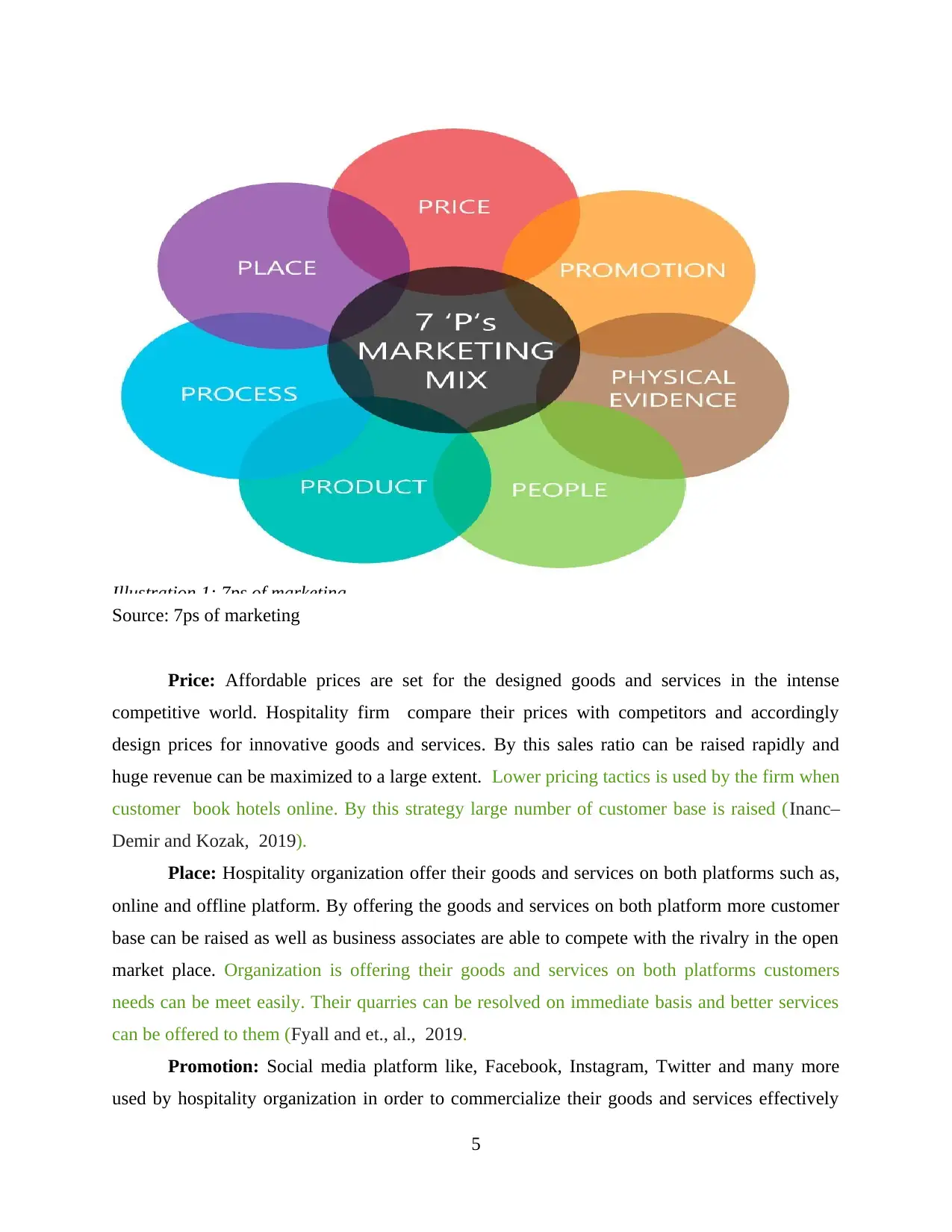
Illustration 1: 7ps of marketing
Source: 7ps of marketing
Price: Affordable prices are set for the designed goods and services in the intense
competitive world. Hospitality firm compare their prices with competitors and accordingly
design prices for innovative goods and services. By this sales ratio can be raised rapidly and
huge revenue can be maximized to a large extent. Lower pricing tactics is used by the firm when
customer book hotels online. By this strategy large number of customer base is raised (Inanc–
Demir and Kozak, 2019).
Place: Hospitality organization offer their goods and services on both platforms such as,
online and offline platform. By offering the goods and services on both platform more customer
base can be raised as well as business associates are able to compete with the rivalry in the open
market place. Organization is offering their goods and services on both platforms customers
needs can be meet easily. Their quarries can be resolved on immediate basis and better services
can be offered to them (Fyall and et., al., 2019.
Promotion: Social media platform like, Facebook, Instagram, Twitter and many more
used by hospitality organization in order to commercialize their goods and services effectively
5
Source: 7ps of marketing
Price: Affordable prices are set for the designed goods and services in the intense
competitive world. Hospitality firm compare their prices with competitors and accordingly
design prices for innovative goods and services. By this sales ratio can be raised rapidly and
huge revenue can be maximized to a large extent. Lower pricing tactics is used by the firm when
customer book hotels online. By this strategy large number of customer base is raised (Inanc–
Demir and Kozak, 2019).
Place: Hospitality organization offer their goods and services on both platforms such as,
online and offline platform. By offering the goods and services on both platform more customer
base can be raised as well as business associates are able to compete with the rivalry in the open
market place. Organization is offering their goods and services on both platforms customers
needs can be meet easily. Their quarries can be resolved on immediate basis and better services
can be offered to them (Fyall and et., al., 2019.
Promotion: Social media platform like, Facebook, Instagram, Twitter and many more
used by hospitality organization in order to commercialize their goods and services effectively
5
Paraphrase This Document
Need a fresh take? Get an instant paraphrase of this document with our AI Paraphraser
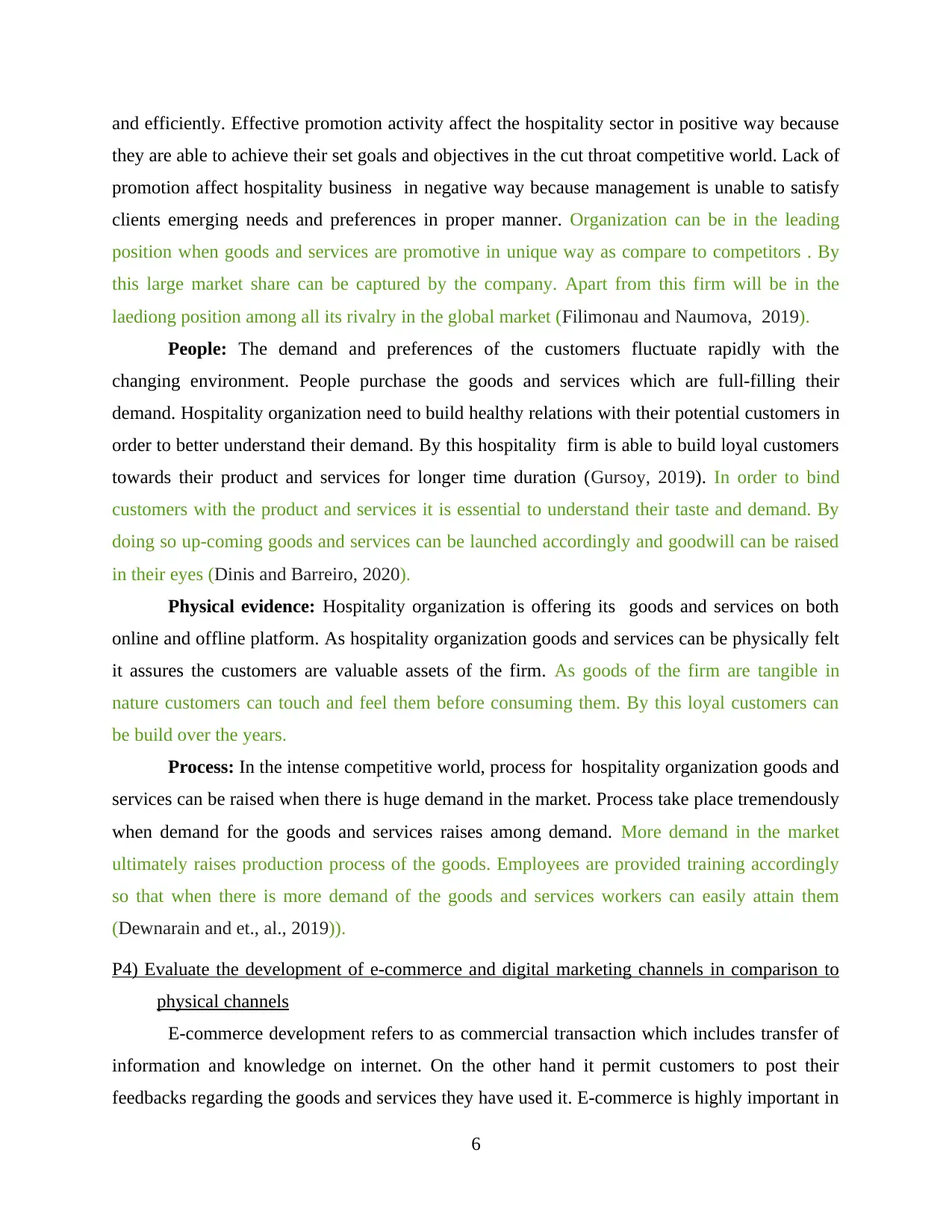
and efficiently. Effective promotion activity affect the hospitality sector in positive way because
they are able to achieve their set goals and objectives in the cut throat competitive world. Lack of
promotion affect hospitality business in negative way because management is unable to satisfy
clients emerging needs and preferences in proper manner. Organization can be in the leading
position when goods and services are promotive in unique way as compare to competitors . By
this large market share can be captured by the company. Apart from this firm will be in the
laediong position among all its rivalry in the global market (Filimonau and Naumova, 2019).
People: The demand and preferences of the customers fluctuate rapidly with the
changing environment. People purchase the goods and services which are full-filling their
demand. Hospitality organization need to build healthy relations with their potential customers in
order to better understand their demand. By this hospitality firm is able to build loyal customers
towards their product and services for longer time duration (Gursoy, 2019). In order to bind
customers with the product and services it is essential to understand their taste and demand. By
doing so up-coming goods and services can be launched accordingly and goodwill can be raised
in their eyes (Dinis and Barreiro, 2020).
Physical evidence: Hospitality organization is offering its goods and services on both
online and offline platform. As hospitality organization goods and services can be physically felt
it assures the customers are valuable assets of the firm. As goods of the firm are tangible in
nature customers can touch and feel them before consuming them. By this loyal customers can
be build over the years.
Process: In the intense competitive world, process for hospitality organization goods and
services can be raised when there is huge demand in the market. Process take place tremendously
when demand for the goods and services raises among demand. More demand in the market
ultimately raises production process of the goods. Employees are provided training accordingly
so that when there is more demand of the goods and services workers can easily attain them
(Dewnarain and et., al., 2019)).
P4) Evaluate the development of e-commerce and digital marketing channels in comparison to
physical channels
E-commerce development refers to as commercial transaction which includes transfer of
information and knowledge on internet. On the other hand it permit customers to post their
feedbacks regarding the goods and services they have used it. E-commerce is highly important in
6
they are able to achieve their set goals and objectives in the cut throat competitive world. Lack of
promotion affect hospitality business in negative way because management is unable to satisfy
clients emerging needs and preferences in proper manner. Organization can be in the leading
position when goods and services are promotive in unique way as compare to competitors . By
this large market share can be captured by the company. Apart from this firm will be in the
laediong position among all its rivalry in the global market (Filimonau and Naumova, 2019).
People: The demand and preferences of the customers fluctuate rapidly with the
changing environment. People purchase the goods and services which are full-filling their
demand. Hospitality organization need to build healthy relations with their potential customers in
order to better understand their demand. By this hospitality firm is able to build loyal customers
towards their product and services for longer time duration (Gursoy, 2019). In order to bind
customers with the product and services it is essential to understand their taste and demand. By
doing so up-coming goods and services can be launched accordingly and goodwill can be raised
in their eyes (Dinis and Barreiro, 2020).
Physical evidence: Hospitality organization is offering its goods and services on both
online and offline platform. As hospitality organization goods and services can be physically felt
it assures the customers are valuable assets of the firm. As goods of the firm are tangible in
nature customers can touch and feel them before consuming them. By this loyal customers can
be build over the years.
Process: In the intense competitive world, process for hospitality organization goods and
services can be raised when there is huge demand in the market. Process take place tremendously
when demand for the goods and services raises among demand. More demand in the market
ultimately raises production process of the goods. Employees are provided training accordingly
so that when there is more demand of the goods and services workers can easily attain them
(Dewnarain and et., al., 2019)).
P4) Evaluate the development of e-commerce and digital marketing channels in comparison to
physical channels
E-commerce development refers to as commercial transaction which includes transfer of
information and knowledge on internet. On the other hand it permit customers to post their
feedbacks regarding the goods and services they have used it. E-commerce is highly important in
6
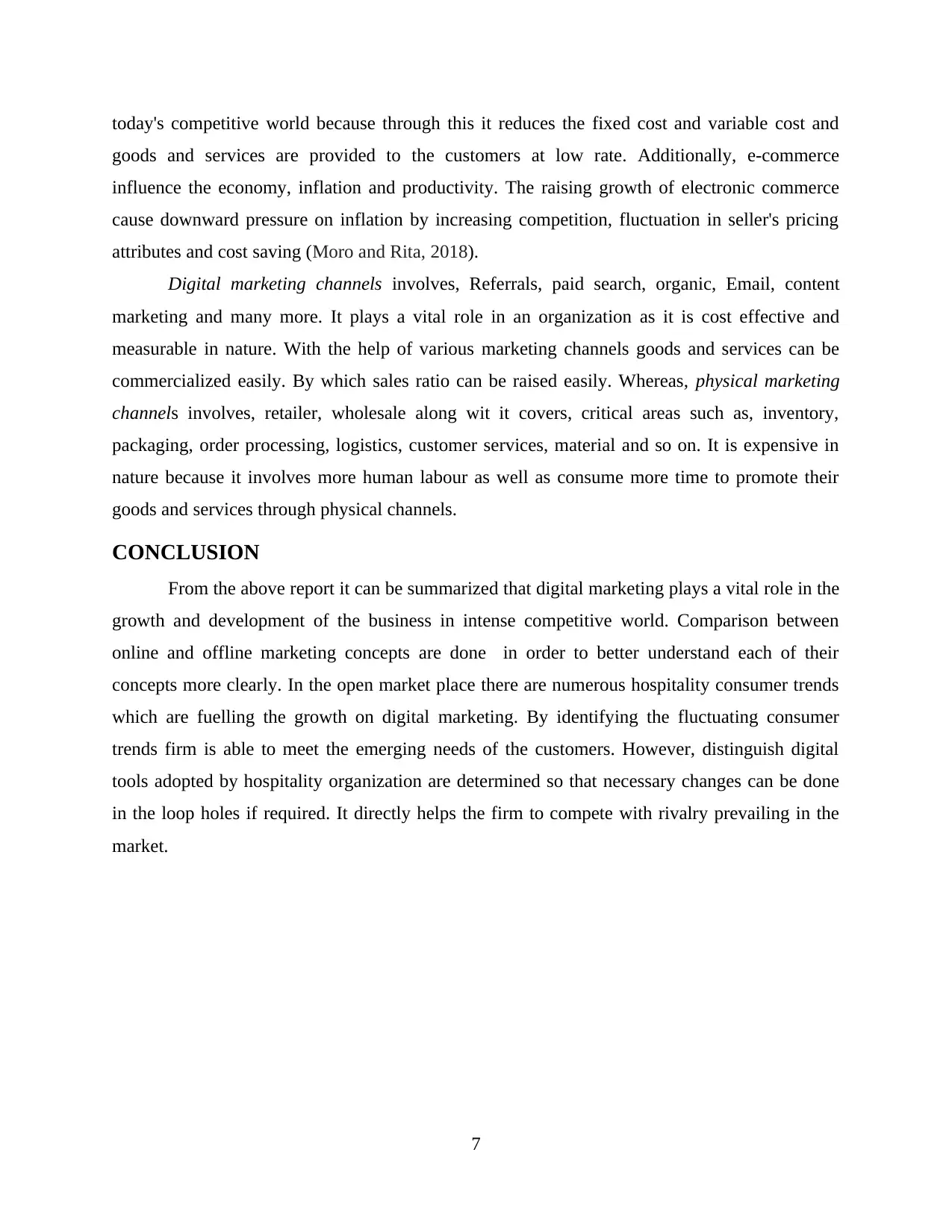
today's competitive world because through this it reduces the fixed cost and variable cost and
goods and services are provided to the customers at low rate. Additionally, e-commerce
influence the economy, inflation and productivity. The raising growth of electronic commerce
cause downward pressure on inflation by increasing competition, fluctuation in seller's pricing
attributes and cost saving (Moro and Rita, 2018).
Digital marketing channels involves, Referrals, paid search, organic, Email, content
marketing and many more. It plays a vital role in an organization as it is cost effective and
measurable in nature. With the help of various marketing channels goods and services can be
commercialized easily. By which sales ratio can be raised easily. Whereas, physical marketing
channels involves, retailer, wholesale along wit it covers, critical areas such as, inventory,
packaging, order processing, logistics, customer services, material and so on. It is expensive in
nature because it involves more human labour as well as consume more time to promote their
goods and services through physical channels.
CONCLUSION
From the above report it can be summarized that digital marketing plays a vital role in the
growth and development of the business in intense competitive world. Comparison between
online and offline marketing concepts are done in order to better understand each of their
concepts more clearly. In the open market place there are numerous hospitality consumer trends
which are fuelling the growth on digital marketing. By identifying the fluctuating consumer
trends firm is able to meet the emerging needs of the customers. However, distinguish digital
tools adopted by hospitality organization are determined so that necessary changes can be done
in the loop holes if required. It directly helps the firm to compete with rivalry prevailing in the
market.
7
goods and services are provided to the customers at low rate. Additionally, e-commerce
influence the economy, inflation and productivity. The raising growth of electronic commerce
cause downward pressure on inflation by increasing competition, fluctuation in seller's pricing
attributes and cost saving (Moro and Rita, 2018).
Digital marketing channels involves, Referrals, paid search, organic, Email, content
marketing and many more. It plays a vital role in an organization as it is cost effective and
measurable in nature. With the help of various marketing channels goods and services can be
commercialized easily. By which sales ratio can be raised easily. Whereas, physical marketing
channels involves, retailer, wholesale along wit it covers, critical areas such as, inventory,
packaging, order processing, logistics, customer services, material and so on. It is expensive in
nature because it involves more human labour as well as consume more time to promote their
goods and services through physical channels.
CONCLUSION
From the above report it can be summarized that digital marketing plays a vital role in the
growth and development of the business in intense competitive world. Comparison between
online and offline marketing concepts are done in order to better understand each of their
concepts more clearly. In the open market place there are numerous hospitality consumer trends
which are fuelling the growth on digital marketing. By identifying the fluctuating consumer
trends firm is able to meet the emerging needs of the customers. However, distinguish digital
tools adopted by hospitality organization are determined so that necessary changes can be done
in the loop holes if required. It directly helps the firm to compete with rivalry prevailing in the
market.
7
⊘ This is a preview!⊘
Do you want full access?
Subscribe today to unlock all pages.

Trusted by 1+ million students worldwide
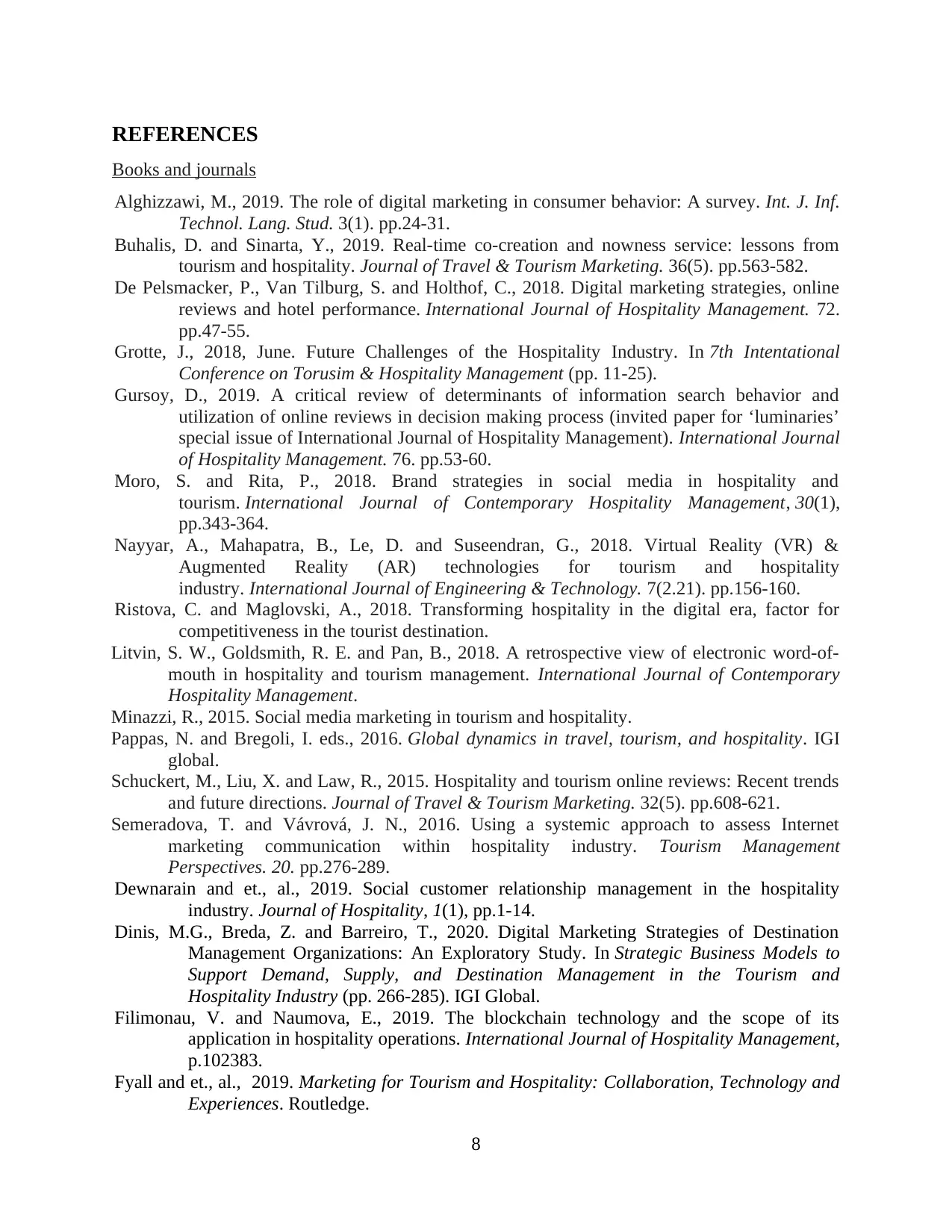
REFERENCES
Books and journals
Alghizzawi, M., 2019. The role of digital marketing in consumer behavior: A survey. Int. J. Inf.
Technol. Lang. Stud. 3(1). pp.24-31.
Buhalis, D. and Sinarta, Y., 2019. Real-time co-creation and nowness service: lessons from
tourism and hospitality. Journal of Travel & Tourism Marketing. 36(5). pp.563-582.
De Pelsmacker, P., Van Tilburg, S. and Holthof, C., 2018. Digital marketing strategies, online
reviews and hotel performance. International Journal of Hospitality Management. 72.
pp.47-55.
Grotte, J., 2018, June. Future Challenges of the Hospitality Industry. In 7th Intentational
Conference on Torusim & Hospitality Management (pp. 11-25).
Gursoy, D., 2019. A critical review of determinants of information search behavior and
utilization of online reviews in decision making process (invited paper for ‘luminaries’
special issue of International Journal of Hospitality Management). International Journal
of Hospitality Management. 76. pp.53-60.
Moro, S. and Rita, P., 2018. Brand strategies in social media in hospitality and
tourism. International Journal of Contemporary Hospitality Management, 30(1),
pp.343-364.
Nayyar, A., Mahapatra, B., Le, D. and Suseendran, G., 2018. Virtual Reality (VR) &
Augmented Reality (AR) technologies for tourism and hospitality
industry. International Journal of Engineering & Technology. 7(2.21). pp.156-160.
Ristova, C. and Maglovski, A., 2018. Transforming hospitality in the digital era, factor for
competitiveness in the tourist destination.
Litvin, S. W., Goldsmith, R. E. and Pan, B., 2018. A retrospective view of electronic word-of-
mouth in hospitality and tourism management. International Journal of Contemporary
Hospitality Management.
Minazzi, R., 2015. Social media marketing in tourism and hospitality.
Pappas, N. and Bregoli, I. eds., 2016. Global dynamics in travel, tourism, and hospitality. IGI
global.
Schuckert, M., Liu, X. and Law, R., 2015. Hospitality and tourism online reviews: Recent trends
and future directions. Journal of Travel & Tourism Marketing. 32(5). pp.608-621.
Semeradova, T. and Vávrová, J. N., 2016. Using a systemic approach to assess Internet
marketing communication within hospitality industry. Tourism Management
Perspectives. 20. pp.276-289.
Dewnarain and et., al., 2019. Social customer relationship management in the hospitality
industry. Journal of Hospitality, 1(1), pp.1-14.
Dinis, M.G., Breda, Z. and Barreiro, T., 2020. Digital Marketing Strategies of Destination
Management Organizations: An Exploratory Study. In Strategic Business Models to
Support Demand, Supply, and Destination Management in the Tourism and
Hospitality Industry (pp. 266-285). IGI Global.
Filimonau, V. and Naumova, E., 2019. The blockchain technology and the scope of its
application in hospitality operations. International Journal of Hospitality Management,
p.102383.
Fyall and et., al., 2019. Marketing for Tourism and Hospitality: Collaboration, Technology and
Experiences. Routledge.
8
Books and journals
Alghizzawi, M., 2019. The role of digital marketing in consumer behavior: A survey. Int. J. Inf.
Technol. Lang. Stud. 3(1). pp.24-31.
Buhalis, D. and Sinarta, Y., 2019. Real-time co-creation and nowness service: lessons from
tourism and hospitality. Journal of Travel & Tourism Marketing. 36(5). pp.563-582.
De Pelsmacker, P., Van Tilburg, S. and Holthof, C., 2018. Digital marketing strategies, online
reviews and hotel performance. International Journal of Hospitality Management. 72.
pp.47-55.
Grotte, J., 2018, June. Future Challenges of the Hospitality Industry. In 7th Intentational
Conference on Torusim & Hospitality Management (pp. 11-25).
Gursoy, D., 2019. A critical review of determinants of information search behavior and
utilization of online reviews in decision making process (invited paper for ‘luminaries’
special issue of International Journal of Hospitality Management). International Journal
of Hospitality Management. 76. pp.53-60.
Moro, S. and Rita, P., 2018. Brand strategies in social media in hospitality and
tourism. International Journal of Contemporary Hospitality Management, 30(1),
pp.343-364.
Nayyar, A., Mahapatra, B., Le, D. and Suseendran, G., 2018. Virtual Reality (VR) &
Augmented Reality (AR) technologies for tourism and hospitality
industry. International Journal of Engineering & Technology. 7(2.21). pp.156-160.
Ristova, C. and Maglovski, A., 2018. Transforming hospitality in the digital era, factor for
competitiveness in the tourist destination.
Litvin, S. W., Goldsmith, R. E. and Pan, B., 2018. A retrospective view of electronic word-of-
mouth in hospitality and tourism management. International Journal of Contemporary
Hospitality Management.
Minazzi, R., 2015. Social media marketing in tourism and hospitality.
Pappas, N. and Bregoli, I. eds., 2016. Global dynamics in travel, tourism, and hospitality. IGI
global.
Schuckert, M., Liu, X. and Law, R., 2015. Hospitality and tourism online reviews: Recent trends
and future directions. Journal of Travel & Tourism Marketing. 32(5). pp.608-621.
Semeradova, T. and Vávrová, J. N., 2016. Using a systemic approach to assess Internet
marketing communication within hospitality industry. Tourism Management
Perspectives. 20. pp.276-289.
Dewnarain and et., al., 2019. Social customer relationship management in the hospitality
industry. Journal of Hospitality, 1(1), pp.1-14.
Dinis, M.G., Breda, Z. and Barreiro, T., 2020. Digital Marketing Strategies of Destination
Management Organizations: An Exploratory Study. In Strategic Business Models to
Support Demand, Supply, and Destination Management in the Tourism and
Hospitality Industry (pp. 266-285). IGI Global.
Filimonau, V. and Naumova, E., 2019. The blockchain technology and the scope of its
application in hospitality operations. International Journal of Hospitality Management,
p.102383.
Fyall and et., al., 2019. Marketing for Tourism and Hospitality: Collaboration, Technology and
Experiences. Routledge.
8
Paraphrase This Document
Need a fresh take? Get an instant paraphrase of this document with our AI Paraphraser
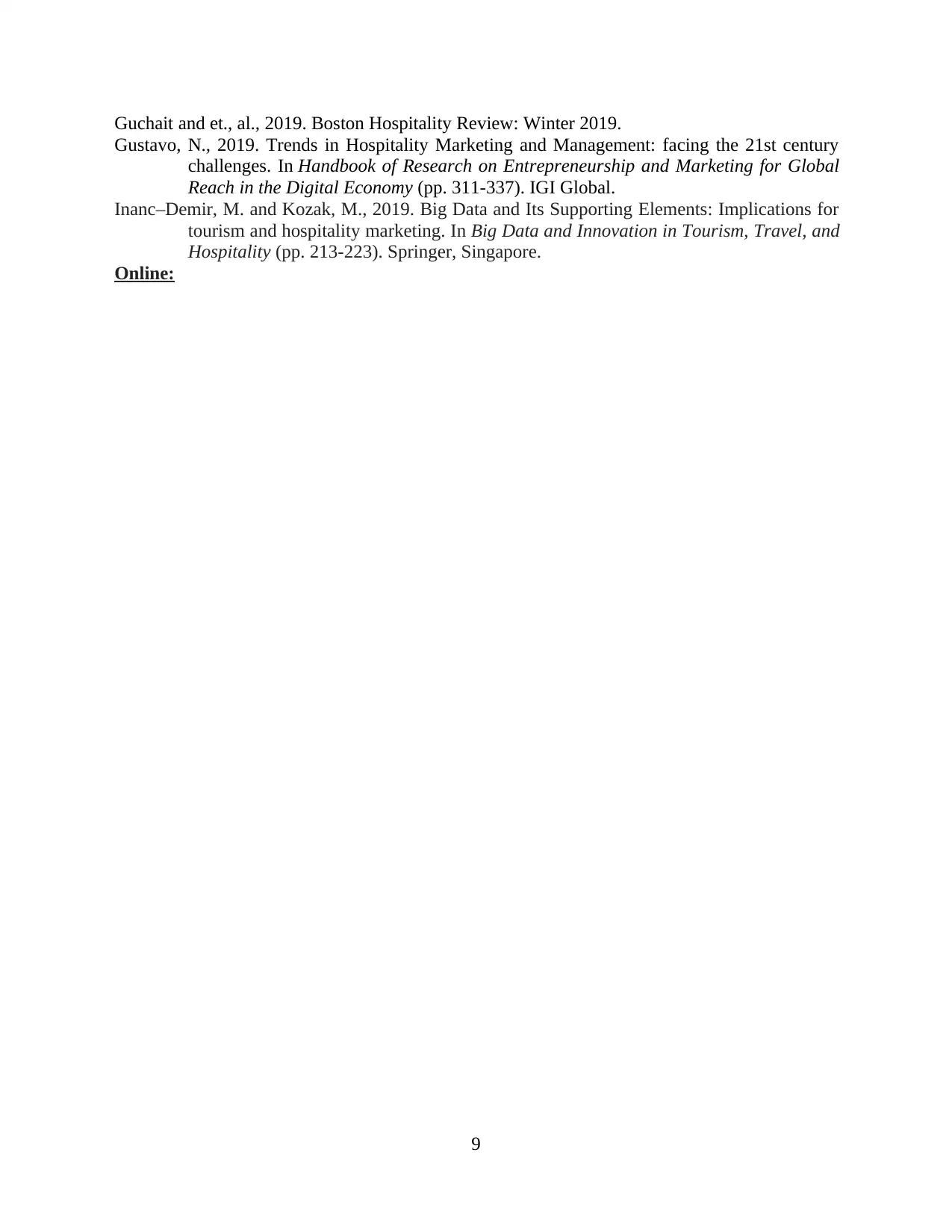
Guchait and et., al., 2019. Boston Hospitality Review: Winter 2019.
Gustavo, N., 2019. Trends in Hospitality Marketing and Management: facing the 21st century
challenges. In Handbook of Research on Entrepreneurship and Marketing for Global
Reach in the Digital Economy (pp. 311-337). IGI Global.
Inanc–Demir, M. and Kozak, M., 2019. Big Data and Its Supporting Elements: Implications for
tourism and hospitality marketing. In Big Data and Innovation in Tourism, Travel, and
Hospitality (pp. 213-223). Springer, Singapore.
Online:
9
Gustavo, N., 2019. Trends in Hospitality Marketing and Management: facing the 21st century
challenges. In Handbook of Research on Entrepreneurship and Marketing for Global
Reach in the Digital Economy (pp. 311-337). IGI Global.
Inanc–Demir, M. and Kozak, M., 2019. Big Data and Its Supporting Elements: Implications for
tourism and hospitality marketing. In Big Data and Innovation in Tourism, Travel, and
Hospitality (pp. 213-223). Springer, Singapore.
Online:
9
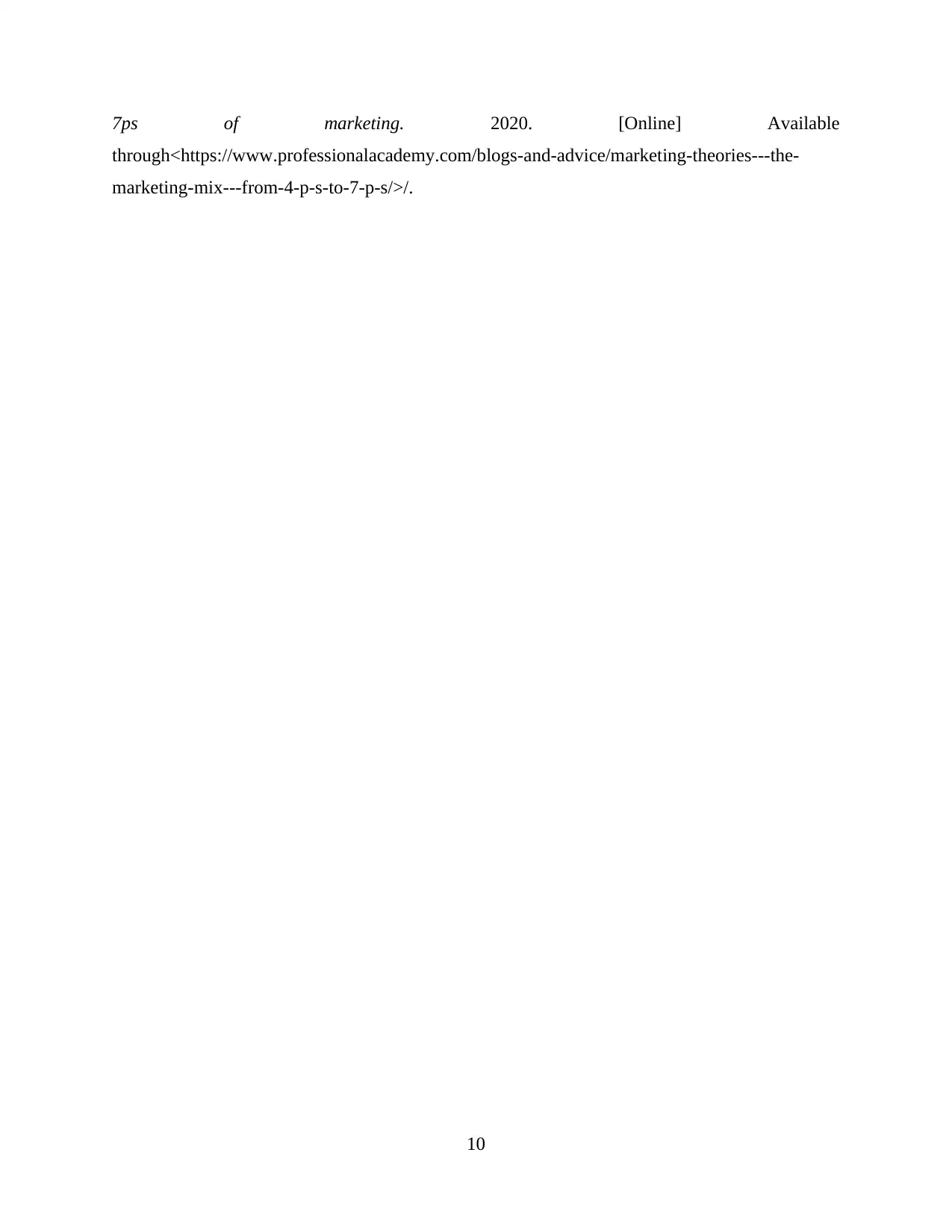
7ps of marketing. 2020. [Online] Available
through<https://www.professionalacademy.com/blogs-and-advice/marketing-theories---the-
marketing-mix---from-4-p-s-to-7-p-s/>/.
10
through<https://www.professionalacademy.com/blogs-and-advice/marketing-theories---the-
marketing-mix---from-4-p-s-to-7-p-s/>/.
10
⊘ This is a preview!⊘
Do you want full access?
Subscribe today to unlock all pages.

Trusted by 1+ million students worldwide
1 out of 12
Related Documents
Your All-in-One AI-Powered Toolkit for Academic Success.
+13062052269
info@desklib.com
Available 24*7 on WhatsApp / Email
![[object Object]](/_next/static/media/star-bottom.7253800d.svg)
Unlock your academic potential
Copyright © 2020–2025 A2Z Services. All Rights Reserved. Developed and managed by ZUCOL.





